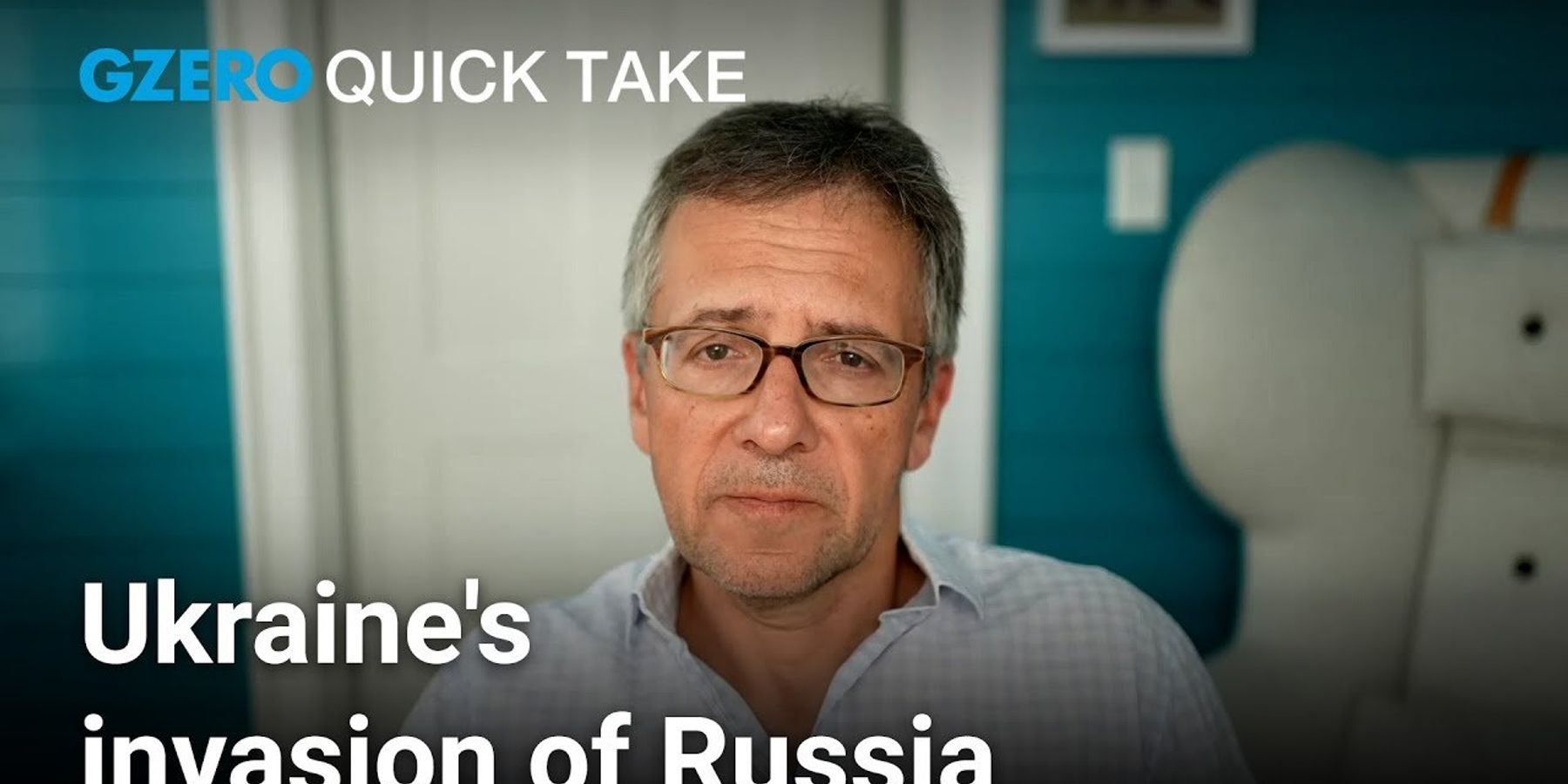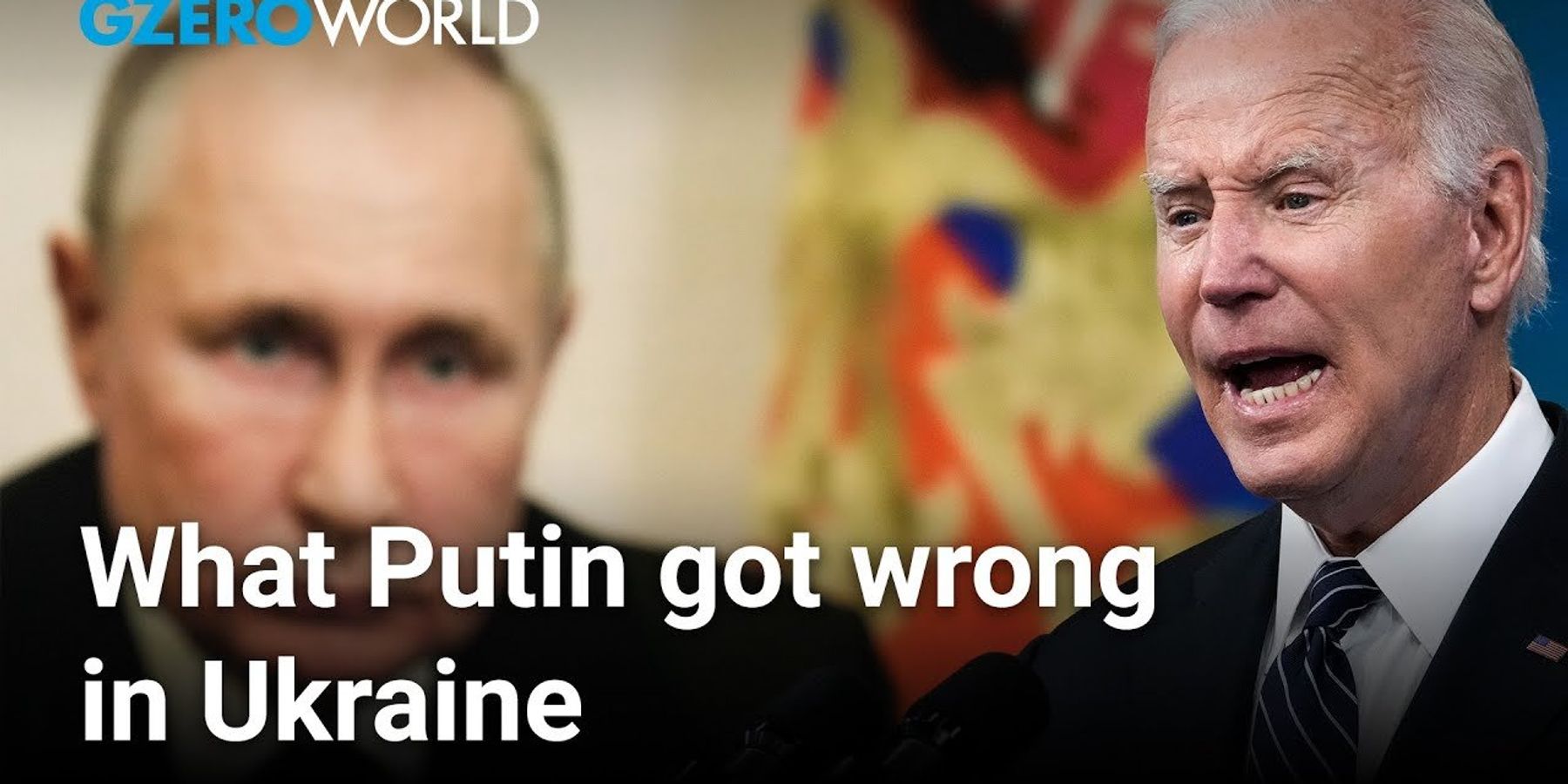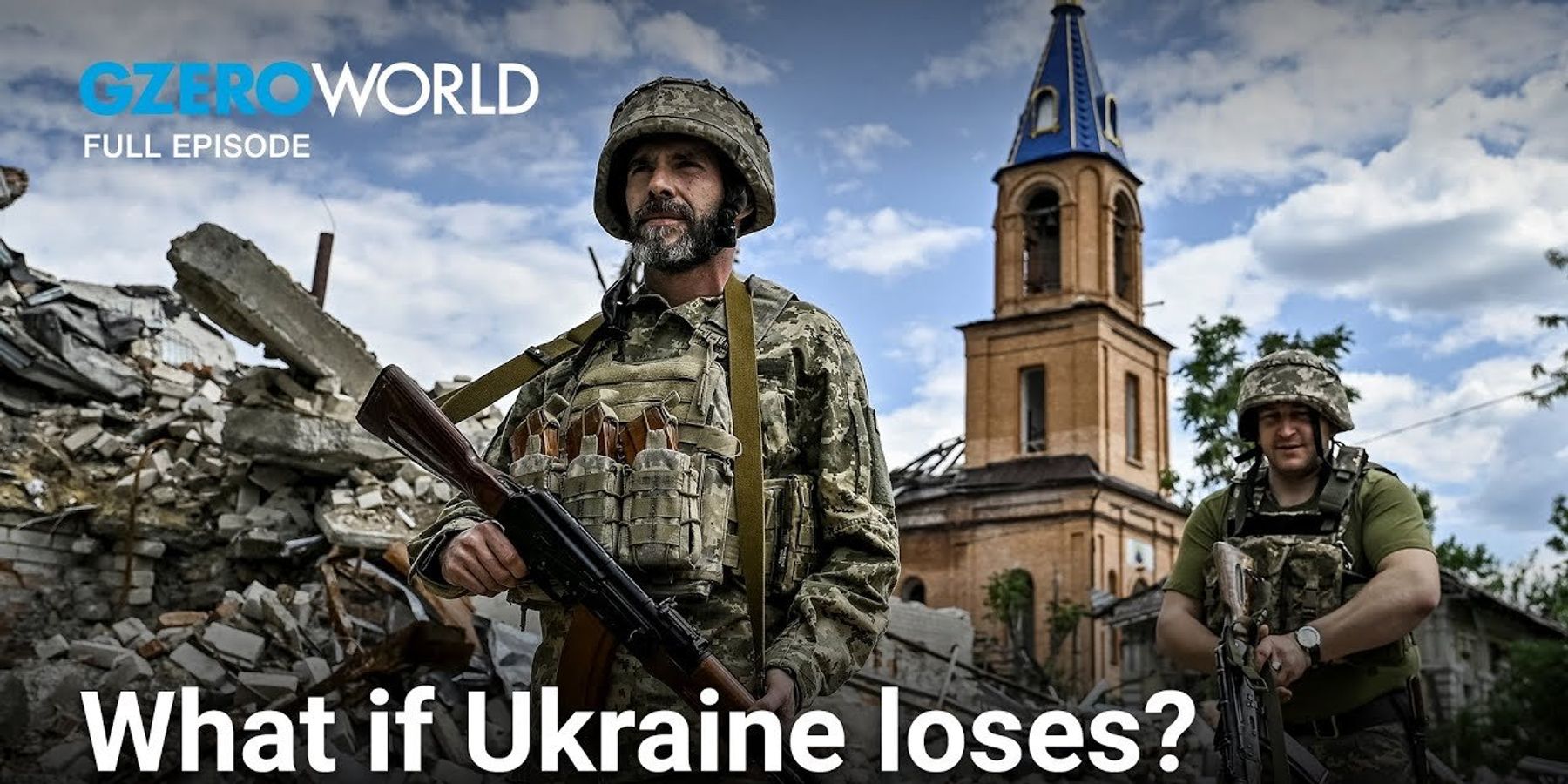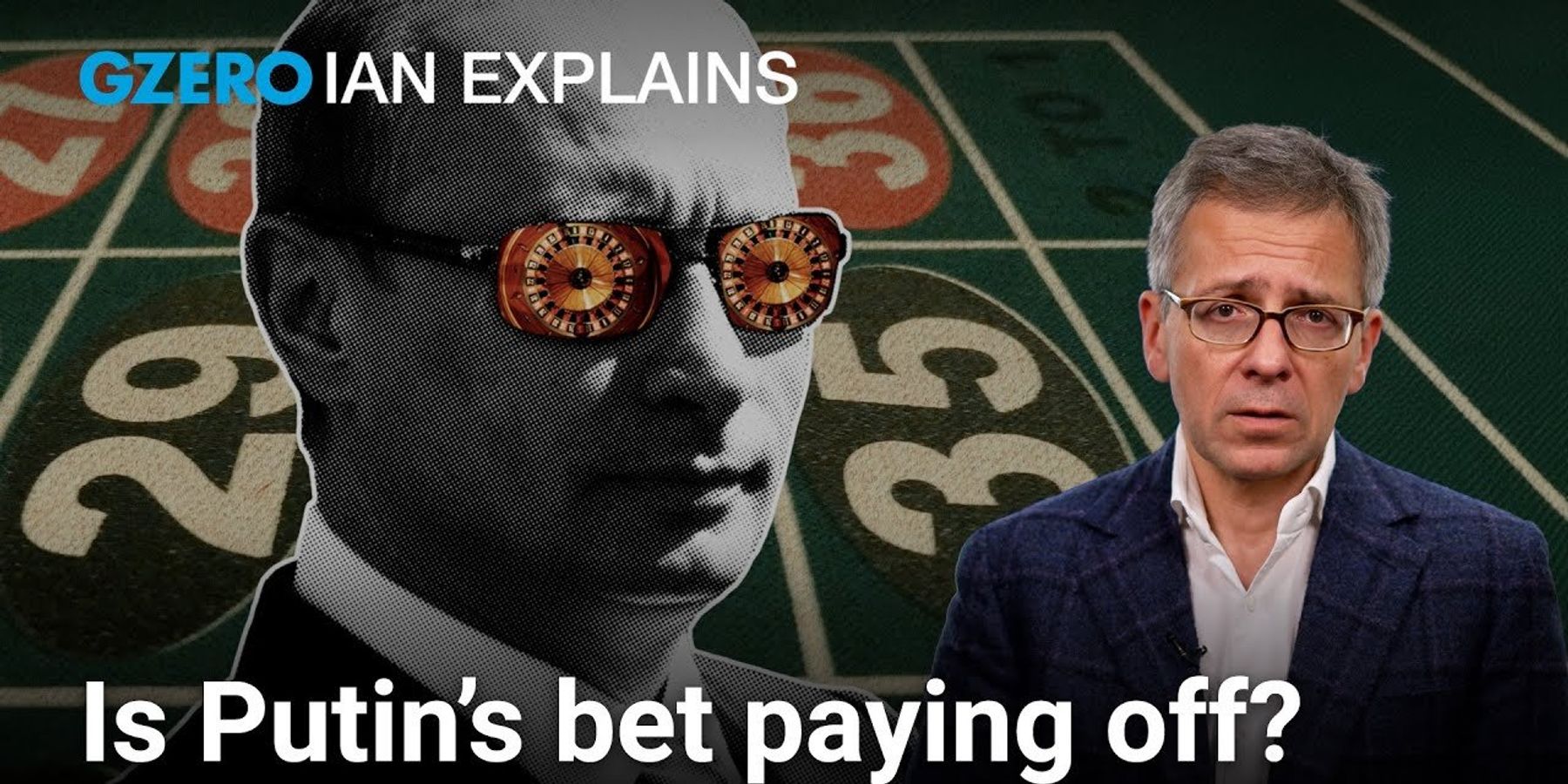Trending Now
We have updated our Privacy Policy and Terms of Use for Eurasia Group and its affiliates, including GZERO Media, to clarify the types of data we collect, how we collect it, how we use data and with whom we share data. By using our website you consent to our Terms and Conditions and Privacy Policy, including the transfer of your personal data to the United States from your country of residence, and our use of cookies described in our Cookie Policy.
{{ subpage.title }}
Vladimir Putin
Putin issues grave warning to NATO over lifting Ukraine missile restrictions
The US and UK this week signaled that they’re leaning toward giving Kyiv permission to use Western-supplied long-range missiles against targets inside Russia. Russian President Vladimir Putin on Thursday said that if the West gives Ukraine the go-ahead, it would mean NATO is “at war” with Russia. He warned that Moscow would take “appropriate” steps in response.
Russia on Friday said it decided to expel six British diplomats, accusing them of spying — a sign of the Kremlin's growing ire over the long-range missile issue. The UK Foreign Office said the allegations were "completely baseless." The move came as British Prime Minister Keir Starmer visits Washington to meet with President Joe Biden for talks on Ukraine, with the matter of whether to lift restrictions on long-range missiles at the top of their agenda.
Meanwhile, Russian drones and missiles, whether intentionally or not, continue to enter the territory of NATO countries in the region, and there’s an evolving debate over whether to shoot them down. Polish Foreign Minister Radosław Sikorski recently said that Poland and other countries in the region had a “duty” to down Russian missiles before they enter their airspace. But this could be seen by Moscow as NATO becoming directly involved in the war and risk escalation — particularly if Ukraine also begins hitting Russia with missiles provided by the West.
That said, NATO doesn’t appear particularly eager to take this step. NATO Deputy Secretary-General Mircea Geoană recently condemned Russia over a drone that flew into Romania’s airspace, calling it “irresponsible and potentially dangerous.” But Geoana also said the alliance had “no information indicating an intentional attack by Russia against Allies.”
We’ll be watching to see if the US and UK ultimately decide to lift restrictions on long-range missiles in the near future, which Ukraine continues to push for at a pivotal moment in the war.
Is it time for Ukraine to negotiate with Russia? Journalist Yaroslav Trofimov explains Kyiv's perspective
Listen: Ukraine is at a crossroads. It's been more than two years of brutal, deadly conflict. Despite some shifts to the front lines, neither side has a clear path to military victory, and support for the war effort is flagging amongst Ukrainians. Is it time for President Zelensky to think about negotiating an end to the war? On the GZERO World Podcast, Ian Bremmer sits with Yaroslav Trofimov, Wall Street Journal Chief Foreign Affairs Correspondent and author of "Our Enemies Will Vanish," about the challenges Ukraine faces, including waning morale and difficulties in military recruitment. Although recent polls indicate that Ukrainians are more receptive to peace talks, Trofimov warns that Russia’s endgame remains unchanged—total erasure of Ukrainian national identity. With the painful history of Soviet-Era aggression still fresh in the national memory, most Ukrainians are resolute that they won’t accept compromise unless it means the return of all internationally recognized land. Trofimov cautions that the absence of security guarantees by NATO and Western allies means Russia's assault on Ukraine is far from over.
Though Bremmer and Trofimov spoke in July before Ukraine’s incursion into Russia’s Kursk region, the larger picture remains bleak: no clear path to ending the war, hundreds of thousands of lives lost, and nearly 20% of Ukraine still under occupation. And if Donald Trump wins a second term, continued US military support is uncertain. So, is it time for Ukraine to negotiate with Russia for a swift end to the war? If not, what will be the cost of all this suffering?
Subscribe to the GZERO World Podcast on Apple Podcasts, Spotify, Stitcher, or your preferred podcast platform, to receive new episodes as soon as they're published.
- Podcast: Russia's view of the Ukraine war: a Kremlin ally's perspective ›
- Why the world isn't fair: Yuval Noah Harari on AI, Ukraine, and Gaza ›
- Is Ukraine running out of time? Former US ambassador Ivo Daalder sizes up the Russia-Ukraine war ›
- Tucker Carlson returns: fact-checking his Ukraine episode ›
Why Ukraine invaded Russia
Ian Bremmer's Quick Take: A Quick Take to kick off your week. I wanted to talk a little bit about Russia/Ukraine before news in the United States and the Middle East take it off the headlines again.
The surprise, of course, is that the Ukrainians have invaded Russia. This was a substantial, you'd say more than an incursion, a significant amount of territory presently being held. The Russians have had to, as a consequence, announce a "counter-terrorism operation regime" in Kursk, in Bryansk, and Belgorod, not martial law, but still, that has reduced some of the forces that they can deploy in fighting the front lines in Southeast Ukraine. And it's also certainly embarrassed Putin, embarrassed his senior military leadership. This is supposed to be all about defeating the Ukrainians, and now the Russians have lots of citizens that are facing a war on Russian territory. Now, to be clear, the Ukrainians have no territorial claim on any part of Russia, but there is a feeling of turnabout is fair play.
What's going on here? I think there are a few things. First of all, the fact that the Ukrainians can put the Russians under some pressure domestically in a run-up to what everyone expects will eventually be negotiations helps to improve Ukraine's position. And no matter who you talk to, the Europeans, the Democrats in the US, the Republicans in the US, the feeling increasingly is that it is going to be harder for the Ukrainians to continue to fight and defend their territory the way they have for the last two and a half years. And so that means you need to have negotiations in the coming year. Part of that is because the Ukrainians aren't going to have the troops. Part of it is because it's getting harder to raise the money. And that's not just the United States, though there was a fight about that, and certainly it'll get harder next year, especially if Trump/Vance win, but also if Harris/Walz do, but also the Germans just cut back 50% of their expected support for the Ukrainian military in 2025, because they're under fiscal constraints, this is the largest European economy. So either way, there is a clear understanding from all sides that you want to move towards freezing the conflict at a minimum and negotiations and maybe a ceasefire and a longer-term settlement, more ambitiously. Much better from the Ukrainian perspective to do that if they have leverage over Russia too, and they have shown leverage. They can blow up the Black Sea fleet, which was important to Russia's national security, and they can put some areas of Russia, both in terms of missiles and alts and drones, but also in terms of Ukrainian troops at risk.
Now, can the Ukrainians hold Kursk from the Russians? Hard to imagine that. I expect that within the coming weeks they'll be forced out of that territory by the Russians. But clearly, they had the element of surprise. The Russians weren't ready to immediately defend or immediately counterattack against that incursion. So I suspect this is more about the broader negotiations between Russian Ukraine than the idea that there's going to be a territory swap. I don't think you'll get there. I also think there is a little bit of desperation. If you're the Ukrainians, remember, you're running out of troops. So sending more troops into Kursk makes you more vulnerable and weaker on the home front, especially when it's been harder and harder to mobilize those troops. And there's been political opposition to doing that. And I think that's because the Ukrainians understand that they need to make Russia feel insecure sooner rather than later, because it's going to be hard to keep this fighting up for another one, two years or more, irrespective of how the American election goes, but certainly, if it goes against the Ukrainians, that's going to be a problem for them. So this isn't all about that.
Also, we're learning more about Russian response. Let's keep in mind that we've heard from Russian leaders, including former President Medvedev and occasionally even Putin himself, that nuclear weapons, tactical nuclear weapons are on the table, and don't you dare, sort of, allow the Ukrainians to use weapons that could strike into Russia. Don't you dare hit Crimea. Don't you dare hit Russian territory. And every time those ostensible red lines have been broken, the Russian response has been dramatically more restrained than one might have expected from listening to Putin and the Kremlin at face value. That's useful because they've also said similar things about Ukraine in NATO and the West defending Ukraine. And if you're going to get to a negotiated settlement that is acceptable for the Ukrainians, which means that they're going to lose territory, they will be partitioned. They need to have the ability to defend their territory for the long-term in a credible way. And the best way to ensure that is get them into NATO. The best way to ensure that is to get them troops on the ground in territory that the Russians don't occupy.
Now, you can have an alliance, have security guarantees that don't include the entire territory. Japan, for example, has an alliance with the United States. It doesn't include the Northern territories, contested and presently occupied, some of them by Russia. So there's plenty of precedent here. But the point is that few in NATO believe today that Ukraine in NATO, especially the piece of Ukraine that isn't occupied by Russia in NATO, is an existential risk for World War III the way that many of them would've believed that when Russian retaliation and escalation was less known, was less experienced a year ago, certainly two years ago. So, that's interesting.
Final point I want to raise here is that whether Harris or Trump win the election in November, I think we are moving towards a similar outcome. In other words, both of these leaders would like to see an end to the fighting. Both of them would like to see a ceasefire. Both of them would like to see the west move on because they recognize the reality of the fighting on the ground, and in the case of Trump in particular, because he wants to say, "New wars started under Biden/Harris, I end them." The big difference between the two is that Trump is much more likely to make those decisions unilaterally. In other words, tell the Ukrainians and the Russians, "This is the deal, accept it or else," and not necessarily coordinate with NATO allies in advance. Where a Harris administration would be working closely in multilateral fashion with the Europeans and with the Ukrainians to try to get to a similar outcome. In other words, more risk acceptant towards that outcome on the Trump side, more risk averse and more coordinated with allies, harder to get done in some ways, under a Harris administration, but lower likelihood that it really blows up in your face. So how lucky do you feel is the open question, but not as dramatically different as the media would have led you to expect over the course of the past months talking about a potential Trump administration.
So that's a little bit from me on where we are, a very different position in some ways, in the Russia/Ukraine war today, and maybe even, I don't want to call it optimistic, but maybe seeing more of a pathway towards how this fighting can be frozen, if not ended. That's it for me, and I'll talk to you all real soon.
- Ian Explains: Putin's Ukraine gamble ›
- Will China end Russia’s war? ›
- Russia-Ukraine reality check ›
- Russia-Ukraine war: How we got here ›
- Is Russia winning the war in Ukraine? ›
- Ukraine's Kursk invasion complicates Putin's war efforts - GZERO Media ›
- Ukraine's military technology could benefit all of Europe — Deputy Minister Anna Gvozdiar - GZERO Media ›
- A Baltic warning: What Ukraine war means for Europe—and the Russian perspective - GZERO Media ›
- Is Ukraine ready to end the war? - GZERO Media ›
- Is Putin's goal to erase Ukraine's identity? - GZERO Media ›
NATO is "back to basics" defending Europe from an aggressive Russia
NATO’s renewed strength and commitment to its original mission of countering an aggressive Russia in Europe was on full display at the alliance's 75th-anniversary summit in Washington, DC. On GZERO World, Ian Bremmer sat down with Poland Foreign Minister Radek Sikorski on the sidelines of the summit to discuss the mood among NATO allies and Sikorski’s assessment of the battlefield two and a half years into a bloody, brutal war with no end in sight. Sikorski, whose country shares a 300+ mile border with Ukraine, remains optimistic that Russian defeat is inevitable.
“Putin misjudged us. He thought Ukraine would just cave in and he’d walk into a victory parade,” Sikorski says, “I don’t think in his worst dreams he anticipated we’d be spending hundreds of billions on arms and ammunition and that two years on, he’d still be controlling only 20% of Ukrainian territory.”
Sikorski says that Putin’s war crimes, including attacks on civilian infrastructure and a children’s hospital, have only strengthened Western resolve. He points to the heavy casualties and economic strain Russia faces, predicting a potential collapse of the Russian economy if the war continues. He notes Ukraine’s strategic victories against a much larger army, such as taking out the Russian fleet in the Black Sea without a navy. Sikorski says it’s in NATO’s best interest to keep sending weapons and financial aid to Kyiv because the cost of not sending assistance will ultimately be much higher.
“It's the cheapest and most effective way to signal to Putin, but also to others,” Sikorski insists, “that regaining what you regard as a renegade province is harder than you think."
Watch the full episode: Ukraine can still win this war, says Poland's FM
Season 7 of GZERO World with Ian Bremmer, the award-winning weekly global affairs series, launches nationwide on public television stations (check local listings).
New digital episodes of GZERO World are released every Monday on YouTube. Don''t miss an episode: subscribe to GZERO's YouTube channel and turn on notifications (🔔).
At NATO Summit, Polish FM Radek Sikorski weighs in on Ukraine war
Listen: Does Ukraine have the strength, stamina, and support to win the war against Russia? On the GZERO World Podcast, Ian Bremmer sat down with Polish Foreign Minister Radek Sikorski on the sidelines of NATO’s 75th-anniversary summit in Washington, DC, for his perspective on the war, European unity, and whether NATO allies can remain united long enough to see Ukraine through to victory. Despite uncertainty about the 2024 US election, Ukraine’s struggle to recruit new troops, and rogue alliance member Hungarian Prime Minister Victor Orbán meeting with Putin, Sikorski is confident Ukraine will ultimately prevail.
Poland is an important part of that defense strategy. The country, which has a 300-mile border with Ukraine, contributes a larger percentage of its GDP to defense spending than any other NATO member, including the US, and has taken in almost a million Ukrainian refugees. Sikorski says that NATO is “back to basics” in its original mission of repelling and defending against an aggressive Russia and that Putin severely misjudged the strength of European and NATO unity in the lead-up to the invasion. Two and a half years into a bloody, brutal war with no end in sight, making sure that unity remains rock solid for as long as Ukraine needs is an urgent priority.
Subscribe to the GZERO World Podcast on Apple Podcasts, Spotify, or your preferred podcast platform, to receive new episodes as soon as they're published.
- Ian Explains: Why Biden is the focus of the NATO Summit ›
- NATO Summit: Biden's uncertain future worries US allies ›
- Podcast: Why Putin will fail: former Finnish PM Alexander Stubb ›
- Is Ukraine running out of time? Former US ambassador Ivo Daalder sizes up the Russia-Ukraine war ›
- Czech president Petr Pavel: Ukraine war fatigue weakening NATO unity against Russia - GZERO Media ›
Is Russia winning the war in Ukraine?
What would Ukraine’s defeat look like? Over two years into this bloody conflict, Russia has never been as close to victory as it is today. “When the history of this war is written,” former US Ambassador to NATO Ivo Daalder tells Ian Bremmer, “I think we’ll look back on the last six months as really… the turning point." Daalder joins Bremmer on the latest episode of GZERO World from Tallinn, Estonia, just a couple hundred miles from the Russian border.
"We need to start having a conversation about how serious this is, and are we going to accept this?" In a sobering and wide-ranging interview, Daalder outlines Russia's advantage on the battlefield today. “They just have more people, they have more guns, and importantly, it looks like they have more and better morale, which makes them willing to do things that otherwise people aren't willing to do."
How much is this battlefield mismatch due to a delay in US support? A big part of it, says Daalder. “Congress refusing to act on the requests that the president first made back in July…and nothing happening until mid-April” was a major blow to Ukraine’s defenses, Daalder says. “And now it just takes time to get stuff to the front and get it across the border and to the units in the quantities to make it happen.”
Is it too late for the West to help Ukraine ward off total defeat? And what would lasting peace, as remote as it might seem now, look like?
Catch GZERO World with Ian Bremmer every week on US public television (check local listings) and online.
- Two years of war in Ukraine: Power players at the Munich Security Conference weigh in ›
- Ukraine waits for help as Russia advances ›
- Russia-Ukraine war: How we got here ›
- Russia-Ukraine: Two Years of War ›
- Why Ukraine invaded Russia - GZERO Media ›
- Ukraine's capture of POWs undermines Russia's narrative - GZERO Media ›
- Why Canadians are tired of Justin Trudeau - GZERO Media ›
- NATO likely to respond if Russia sends North Korean troops to Ukraine - GZERO Media ›
- GZERO World with Ian Bremmer: 2024's top 10 most quotable moments - GZERO Media ›
- Ukraine's military technology could benefit all of Europe — Deputy Minister Anna Gvozdiar - GZERO Media ›
- Is Ukraine ready to end the war? - GZERO Media ›
- The fight to decide Ukraine's fate - GZERO Media ›
- Ukraine war: What freedom looks like - GZERO Media ›
- Is Putin's goal to erase Ukraine's identity? - GZERO Media ›
Is Ukraine running out of time? Former US ambassador Ivo Daalder sizes up the Russia-Ukraine war
Listen: Could the last six months be the most pivotal months of the entire Russia/Ukraine war? Over two years into the conflict, Russia is closer to victory in Ukraine than ever before, according to former US Ambassador to NATO Ivo Daalder. He joins Ian Bremmer on the GZERO World Podcast from Tallinn, Estonia, mere miles from the Russian border.
How much is this battlefield mismatch due to a delay in US support? A big part of it, says Daalder. “Congress refusing to act on the requests that the president first made back in July…and nothing happening until mid-April” was a major blow to Ukraine’s defenses, Daalder says. “And now it just takes time to get stuff to the Front and get it across the border and to the units in the quantities to make it happen.”
Subscribe to the GZERO World Podcast on Apple Podcasts, Spotify, Stitcher, or your preferred podcast platform, to receive new episodes as soon as they're published.
- Ian Explains: What the war in Ukraine looks like inside Russia ›
- Ukraine waits for help as Russia advances ›
- Will China end Russia’s war? ›
- Ukraine will define the future of NATO ›
- Will Ukrainian airstrikes inside Russia shift the war? - GZERO Media ›
- At NATO Summit, Polish FM Radek Sikorski weighs in on Ukraine war - GZERO Media ›
- Ian Explains: Will Ukraine ever negotiate with Russia? - GZERO Media ›
- Czech president Petr Pavel: Ukraine war fatigue weakening NATO unity against Russia - GZERO Media ›
Ian Explains: Putin's Ukraine gamble
Is Ukraine losing the war? A year and a half ago, Russia was in bad shape. Moscow was struggling to resupply troops on the front lines, its naval fleet in the Black Sea was decimated, and troop casualty estimates were as high as half a million. However, a disappointing Ukrainian counteroffensive and a six-month delay in crucial US military aid gave Moscow an opportunity to rearm and regroup.
On Ian Explains, Ian Bremmer examines the state of the battlefield in Ukraine and unpacks how Russia has been able to take territory in recent weeks at a faster clip than at any point during the war. In a sign of just how badly the situation is deteriorating, Ukraine’s President Volodymyr Zelensky abruptly canceled all international trips to focus on the Russian offensive, a huge problem for a leader who needs to lobby governments for military and economic aid individually.
All eyes will be on this year’s NATO Summit in Washington, DC, where Western leaders are trying to lock in as many security guarantees for Kyiv as possible ahead of the alliance’s 75th anniversary. The problem is that they don’t have much time to figure it out.
Watch the upcoming episode of GZERO World with Ian Bremmer on US public television this weekend (check local listings) and at gzeromedia.com/gzeroworld.
- Tucker Carlson returns: fact-checking his Ukraine episode ›
- Putin is responsible for bloodshed in Ukraine, and Ukraine's pro-Western positions ›
- Russia is winning? Winning what? ›
- Russia-Ukraine: Two Years of War ›
- Will Ukrainian airstrikes inside Russia shift the war? - GZERO Media ›
- Why Ukraine invaded Russia - GZERO Media ›
- Ukraine's Kursk invasion complicates Putin's war efforts - GZERO Media ›
- Putin's strategy in Ukraine ahead of Trump's return - GZERO Media ›
- Putin isn't winning in Ukraine, says US National Security Advisor Jake Sullivan - GZERO Media ›
- Trump's call with Putin is big win for Kremlin - GZERO Media ›
- Is Ukraine ready to end the war? - GZERO Media ›
- Ukraine frustrated by delay on long-range weapons - GZERO Media ›
- Why Putin agreed to the US-Russia prisoner swap - GZERO Media ›
- Ukraine war: What freedom looks like - GZERO Media ›



